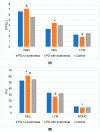Changes in the Secretion of Melatonin and Selected Adipokines during the Progression of Parkinson's Disease-Preliminary Studies
- PMID: 37233709
- PMCID: PMC10221412
- DOI: 10.3390/metabo13050668
Changes in the Secretion of Melatonin and Selected Adipokines during the Progression of Parkinson's Disease-Preliminary Studies
Abstract
Parkinson's disease (PD) is one of the most common neurodegenerative diseases affecting elderly people. Considering the gap in the literature on melatonin and adipokine levels in PD patients at various stages of the disease, we conducted a study to investigate the levels of selected parameters in PD patients at the disease's early (ES) and advanced (AS) stages. Melatonin, leptin, adiponectin, and resistin concentrations were measured in the blood serum of 20 PD patients without dyskinesia (ES), 24 PD patients with dyskinesia (AS), and 20 healthy volunteers as a control group (CG). The data were analyzed using ANOVA. Melatonin was significantly lower in ES (p < 0.05) and higher in AS patients (p < 0.05) compared to CG. The level of leptin was increased both in ES (p < 0.001) and AS (p < 0.001) versus CG, while resistin was increased only in patients with dyskinesia (p < 0.05). Higher melatonin (p < 0.001) and resistin (p < 0.05) and lower leptin (p < 0.05) levels were found in AS versus ES. The main findings of the study include the changes in inflammatory markers' levels during PD and a surprising increase in melatonin level in dyskinesia patients. Further research is necessary, which will be aimed at modulating the secretion of melatonin and adipokines as a treatment target for PD.
Keywords: Parkinson’s disease; adiponectin; dyskinesia; leptin; melatonin; resistin.
Conflict of interest statement
The authors declare no conflict of interest.
Figures




References
-
- Gustafson B., Jack M.M., Cushman S.W., Smith U. Adiponectin Gene Activation by Thiazolidinediones Requires PPARγ2, but Not C/EBPα—Evidence for Differential Regulation of the AP2 and Adiponectin Genes. Biochem. Biophys. Res. Commun. 2003;308:933–939. doi: 10.1016/S0006-291X(03)01518-3. - DOI - PubMed
Grants and funding
LinkOut - more resources
Full Text Sources
Research Materials
Miscellaneous

